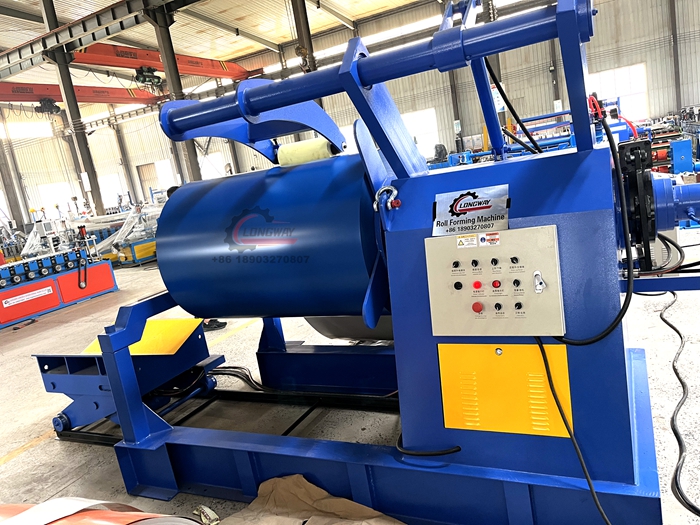Drip Edge Roll Forming Equipment for Efficient Roofing Solutions and Design Innovations
Understanding Drip Edge Roll Forming Machines A Key Tool in Metal Fabrication
In the world of metal fabrication, the drip edge roll forming machine stands out as a vital piece of equipment, particularly for roofing and siding applications. This specialized machine is designed to produce drip edges, which are essential components that help direct water away from the structure, preventing water damage and enhancing durability. This article explores the functionalities, advantages, and applications of drip edge roll forming machines, along with their importance in the manufacturing process.
What is a Drip Edge?
A drip edge is a metal flashing that is installed at the edge of a roof. It serves the primary purpose of directing rainwater away from the fascia and allowing it to flow into the gutters, reducing the risk of moisture infiltration into the underlying structures. By acting as a barrier, drip edges help to protect wooden components from rot and decay. Drip edges can be made from various materials, including aluminum, galvanized steel, and copper, which offer different benefits in terms of durability, cost, and aesthetics.
The Working Principle of Drip Edge Roll Forming Machines
A drip edge roll forming machine operates through a continuous process, where a flat metal sheet is gradually shaped into the desired profile via a series of rollers. The machine typically consists of the following key components
1. Uncoiler This holds the metal coil and feeds it into the machine. 2. Roll Forming Station It features several rollers that progressively form the metal sheet into the drip edge profile. 3. Cutting System After the desired length is achieved, the cutting mechanism trims the sheet to size, ensuring precision. 4. Control System Modern machines often incorporate automated controls that enhance accuracy and ease of operation.
The roll forming process is essential for creating consistent profiles at high speeds while maintaining high accuracy. This is particularly important for manufacturers who require large volumes of drip edges without compromising on quality.
Advantages of Drip Edge Roll Forming Machines
1. Efficiency These machines operate at a high-speed capacity, allowing manufacturers to produce large quantities of drip edges in a relatively short time. This efficiency translates to lower production costs and faster turnaround times.
drip edge roll forming machine

2. Precision Roll forming provides a high degree of accuracy, producing uniform drip edges that meet specific design specifications. This precision minimizes waste and ensures that parts fit correctly during installation.
3. Versatility Drip edge roll forming machines can be adapted to produce different profiles and sizes, making them highly versatile. Manufacturers can switch between different sets of rollers to create custom designs tailored to client needs.
4. Cost-Effectiveness By using materials efficiently and reducing waste, these machines help lower overall production costs. Additionally, their durability means that they can operate for extended periods, often leading to better ROI for manufacturers.
5. Automation Many contemporary drip edge roll forming machines incorporate automation technologies, making the production process less labor-intensive. This not only reduces labor costs but also minimizes human error.
Applications of Drip Edge Roll Forming Machines
While primarily used in roofing applications, the versatility of drip edge roll forming machines means they can also be employed in various industries, including
- Residential and Commercial Roofing In both new constructions and renovations, drip edges are crucial for protecting roofs from water damage. - Siding and Wall Cladding These machines can produce drip edges that are compatible with different siding materials, enhancing the overall weather resistance of buildings. - Custom Fabrication Manufacturers can create unique drip edge profiles for specialized applications or aesthetic preferences.
Conclusion
The drip edge roll forming machine plays an indispensable role in the manufacturing of one of the most critical roofing components. By providing efficiency, precision, and versatility, these machines enable manufacturers to meet the growing demand for high-quality roofing solutions. As technology continues to advance, we can expect further improvements in the design and functionality of drip edge roll forming machines, contributing to more robust and durable construction practices. Whether for residential homes or commercial buildings, understanding and utilizing this technology is essential for any metal fabrication company focused on delivering superior products.
-
Roof Panel Machines: Buying Guide, Types, and PricingNewsJul.04, 2025
-
Purlin Machines: Types, Features, and Pricing GuideNewsJul.04, 2025
-
Metal Embossing Machines: Types, Applications, and Buying GuideNewsJul.04, 2025
-
Gutter Machines: Features, Types, and Cost BreakdownNewsJul.04, 2025
-
Cut to Length Line: Overview, Equipment, and Buying GuideNewsJul.04, 2025
-
Auto Stacker: Features, Applications, and Cost BreakdownNewsJul.04, 2025
-
Top Drywall Profile Machine Models for SaleNewsJun.05, 2025








